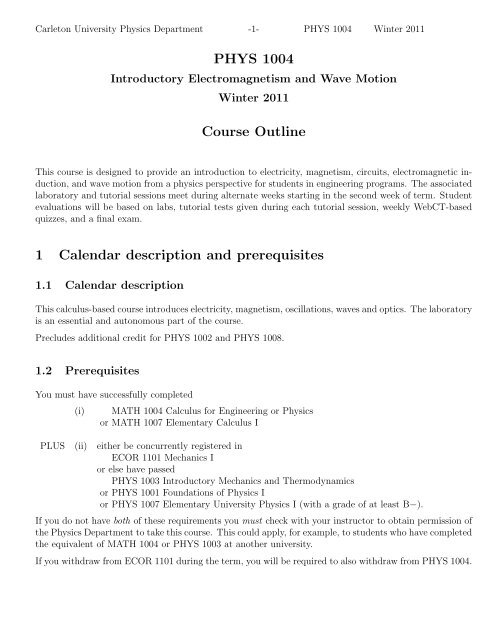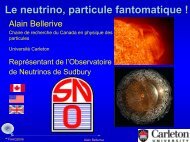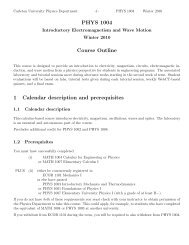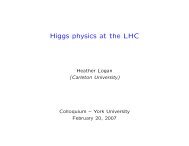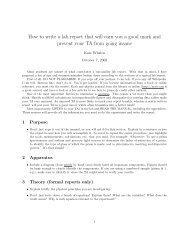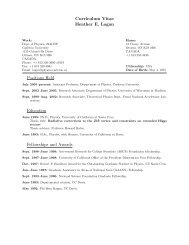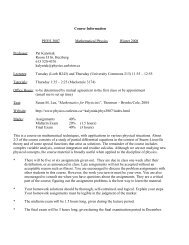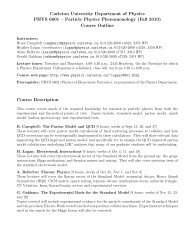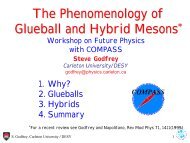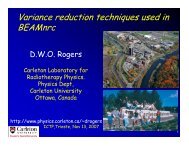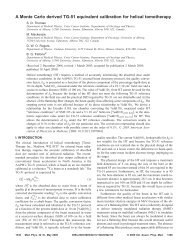PHYS 1004 Course Outline 1 Calendar description and prerequisites
PHYS 1004 Course Outline 1 Calendar description and prerequisites
PHYS 1004 Course Outline 1 Calendar description and prerequisites
You also want an ePaper? Increase the reach of your titles
YUMPU automatically turns print PDFs into web optimized ePapers that Google loves.
Carleton University Physics Department -1- <strong>PHYS</strong> <strong>1004</strong> Winter 2011<br />
<strong>PHYS</strong> <strong>1004</strong><br />
Introductory Electromagnetism <strong>and</strong> Wave Motion<br />
Winter 2011<br />
<strong>Course</strong> <strong>Outline</strong><br />
This course is designed to provide an introduction to electricity, magnetism, circuits, electromagnetic induction,<br />
<strong>and</strong> wave motion from a physics perspective for students in engineering programs. The associated<br />
laboratory <strong>and</strong> tutorial sessions meet during alternate weeks starting in the second week of term. Student<br />
evaluations will be based on labs, tutorial tests given during each tutorial session, weekly WebCT-based<br />
quizzes, <strong>and</strong> a final exam.<br />
1 <strong>Calendar</strong> <strong>description</strong> <strong>and</strong> <strong>prerequisites</strong><br />
1.1 <strong>Calendar</strong> <strong>description</strong><br />
This calculus-based course introduces electricity, magnetism, oscillations, waves <strong>and</strong> optics. The laboratory<br />
is an essential <strong>and</strong> autonomous part of the course.<br />
Precludes additional credit for <strong>PHYS</strong> 1002 <strong>and</strong> <strong>PHYS</strong> 1008.<br />
1.2 Prerequisites<br />
You must have successfully completed<br />
(i)<br />
or MATH <strong>1004</strong> Calculus for Engineering or Physics<br />
or MATH 1007 Elementary Calculus I<br />
PLUS (ii) either be concurrently registered in<br />
or ECOR 1101 Mechanics I<br />
or else have passed<br />
or <strong>PHYS</strong> 1003 Introductory Mechanics <strong>and</strong> Thermodynamics<br />
or <strong>PHYS</strong> 1001 Foundations of Physics I<br />
or <strong>PHYS</strong> 1007 Elementary University Physics I (with a grade of at least B−).<br />
If you do not have both of these requirements you must check with your instructor to obtain permission of<br />
the Physics Department to take this course. This could apply, for example, to students who have completed<br />
the equivalent of MATH <strong>1004</strong> or <strong>PHYS</strong> 1003 at another university.<br />
If you withdraw from ECOR 1101 during the term, you will be required to also withdraw from <strong>PHYS</strong> <strong>1004</strong>.
Carleton University Physics Department -2- <strong>PHYS</strong> <strong>1004</strong> Winter 2011<br />
2 Who teaches the course, when <strong>and</strong> where<br />
2.1 Lecture Timetable<br />
CRN Section Times Room Lecturer Lecturer’s office & contact info<br />
10923 A Wed 10:00–11:30 AT 102 Bruce Campbell Herzberg 3378<br />
Fri 10:00–11:30<br />
campbell@physics.carleton.ca<br />
613-520-2600 x4322<br />
14859 B Tue 19:30–21:00 AT 102 Heather Logan Herzberg 2450<br />
Thu 19:30–21:00 (course logan@physics.carleton.ca<br />
coordinator) 613-520-2600 x4319<br />
10927 C Mon 16:00–17:30 AT 102 Igor Ivanovic Herzberg 3346<br />
Wed 16:00–17:30<br />
igor@physics.carleton.ca<br />
613-520-2600 x5796<br />
10930 M Mon 19:30–21:00 AT 102 Igor Ivanovic Herzberg 3346<br />
Wed 19:30–21:00<br />
igor@physics.carleton.ca<br />
613-520-2600 x5796<br />
2.2 Laboratory <strong>and</strong> Tutorial Timetable<br />
CRN Section Time<br />
10924 A1 Mon 11:30–14:30<br />
10925 A3 Wed 11:30–14:30<br />
10926 A5 Mon 8:30–11:30<br />
14860 B6 Fri 11:30–14:30<br />
14861 B7 Wed 8:30–11:30<br />
14863 B8 Wed 14:30–17:30<br />
10933 C2 Fri 14:30–17:30<br />
10931 C4 Thu 13:30–16:30<br />
10928 C9 Tue 13:30–16:30<br />
10932 M11 ∗ Thu 18:00–21:00<br />
10929 M12 Fri 8:30–11:30<br />
11703 M13 ∗ Tue 18:00–21:00<br />
Room:<br />
Lab supervisor:<br />
Herzberg 4130 (all sections)<br />
Andrew Robinson<br />
( ∗ except Igor Ivanovic<br />
for sections M11 <strong>and</strong> M13)<br />
Supervisor’s office Herzberg 3368<br />
& contact info: robinson@physics.carleton.ca<br />
613-520-2600 x8922
Carleton University Physics Department -3- <strong>PHYS</strong> <strong>1004</strong> Winter 2011<br />
3 Learning outcomes<br />
In the process of successfully completing this course, you will learn how to:<br />
• solve multi-step problems;<br />
• present written solutions to problems in a clear <strong>and</strong> logical way;<br />
• apply calculus techniques to real physical problems;<br />
• underst<strong>and</strong> the concepts of electric <strong>and</strong> magnetic fields <strong>and</strong> the associated forces;<br />
• relate the motion of objects in electric fields to familiar concepts of force, work, <strong>and</strong> kinetic <strong>and</strong><br />
potential energy;<br />
• determine the electric field <strong>and</strong> electric potential due to a known charge distribution using Coulomb’s<br />
law, Gauss’s law, <strong>and</strong> the relationship between electric field <strong>and</strong> potential;<br />
• use the electric field <strong>and</strong> potential formalism to underst<strong>and</strong> capacitors;<br />
• underst<strong>and</strong> electric current <strong>and</strong> the rules for modeling electric circuits from a physics perspective;<br />
• determine the magnetic field due to a known current distribution using the Biot-Savart law <strong>and</strong><br />
Ampère’s law;<br />
• determine the forces on moving charges <strong>and</strong> current-carrying wires due to an external magnetic field,<br />
<strong>and</strong> underst<strong>and</strong> the technological applications of these forces, e.g., in the electric motor <strong>and</strong> electric<br />
generator;<br />
• underst<strong>and</strong> electromagnetic induction, determine the resulting induced currents, <strong>and</strong> underst<strong>and</strong><br />
their consequences;<br />
• underst<strong>and</strong> oscillatory motion using the simple mass-on-a-spring model;<br />
• analyze alternating-current (AC) circuits from a physics perspective;<br />
• underst<strong>and</strong> travelling waves with special emphasis on electromagnetic waves; <strong>and</strong><br />
• analyze the effect of polarizing filters on electromagnetic waves.<br />
In the laboratory portion of this course you will learn how to:<br />
• present the results of laboratory experiments in a clear <strong>and</strong> well-organized written form;<br />
• quantify experimental uncertainties;<br />
• construct circuits from electronic components;<br />
• measure currents <strong>and</strong> voltages in circuits using common measuring devices;<br />
• use an oscilloscope for analysis of electronic signals; <strong>and</strong><br />
• underst<strong>and</strong> the behaviour of direct-current (DC) circuits, resistor-capacitor (RC) circuits, <strong>and</strong> the<br />
use of optical lenses.
Carleton University Physics Department -4- <strong>PHYS</strong> <strong>1004</strong> Winter 2011<br />
4 How to succeed in this course<br />
4.1 Tips for success<br />
• Study effectively. The only way to learn physics is by working the problems. Work <strong>and</strong> rework<br />
all the examples in the text <strong>and</strong> the assigned homework problems. If you can do all the homework<br />
problems by yourself with only the attached formula sheet as an aid, then you’re on the road to a<br />
good mark in the course.<br />
• Do your homework. Aim to work through all the assigned homework problems before your<br />
tutorial. That way you will know what areas you need to focus on during the tutorial when working<br />
in groups <strong>and</strong> getting help from the TAs. Each tutorial test will include long-answer problem(s)<br />
based on the homework problems, so be prepared!<br />
• Take advantage of class time. Attend all the lectures, participate in class discussions <strong>and</strong> exercises,<br />
take notes, <strong>and</strong> don’t be afraid to ask questions. When taking notes, concentrate on the things<br />
that your instructor emphasizes on the chalkboard or slides.<br />
• Use your textbook. Read the assigned sections of the textbook before each class. Review them<br />
again after class <strong>and</strong> annotate your class notes as needed. At the end of each chapter of the textbook<br />
is a one- or two-page review of the important concepts covered in each chapter.<br />
• Get all the term marks you can. Attend all the tutorials <strong>and</strong> be prepared for the tutorial tests.<br />
Attend all the labs <strong>and</strong> turn in all your lab reports on time. Do all the WebCT quizzes on your own<br />
<strong>and</strong> before the deadline. (Note that it is easy to work in groups on the WebCT quizzes <strong>and</strong> get all<br />
the answers from your friends, but this defeats the purpose of learning by doing these problems <strong>and</strong><br />
it will not prepare you for the final exam. The final exam will have many similar problems which are<br />
worth twice as many marks as all the WebCT quizzes put together.)<br />
• Get help if you need it. If you’re having trouble with a concept or homework problem, go to your<br />
instructor’s office hours or the Drop-In Centre for help. We are here to help you learn!<br />
4.2 Getting help<br />
• Office hours: Each of the course instructors will hold office hours a couple times per week. Times<br />
<strong>and</strong> locations will be posted in WebCT <strong>and</strong> announced in class. The instructors can also be reached<br />
by email.<br />
• Drop-In Centre: The Physics Department normally runs a Drop-In Centre staffed by TAs for help<br />
in first-year Physics courses. The times <strong>and</strong> location will be posted in WebCT <strong>and</strong> announced in<br />
class.
Carleton University Physics Department -5- <strong>PHYS</strong> <strong>1004</strong> Winter 2011<br />
5 <strong>Course</strong> components <strong>and</strong> marking scheme<br />
5.1 Marks <strong>and</strong> passing conditions<br />
The marking scheme is as follows:<br />
Theory (total 70%) Weekly WebCT quizzes (best 9 of 11) 10%<br />
Tutorial Tests (best 4 of 5) 25%<br />
Final Exam 35%<br />
Lab Experiments 30%<br />
<strong>Course</strong> total 100%<br />
In order to pass the course, your overall mark must be greater than 50% AND you must achieve 40% or<br />
above on BOTH the Theory AND the Lab Experiments components of the course.<br />
Students with an overall course mark above 50% but who achieve between 40% <strong>and</strong> 49% on either Lab<br />
Experiments or Theory will be given a grade of D−, no matter how good their overall mark is.<br />
5.2 Weekly WebCT quizzes<br />
Each week you will have a WebCT-based quiz consisting mostly of conceptual questions or questions<br />
requiring a brief calculation. The purpose of these quizzes is to help you learn the material <strong>and</strong> verify your<br />
basic underst<strong>and</strong>ing before you move on to the more complicated homework problems associated with the<br />
Tutorials. Each week there will be a Self-Quiz that you can do for practice as many times as you like, <strong>and</strong><br />
a time-limited Quiz that will be graded. You should read the relevant textbook sections before you start<br />
the time-limited quiz. The quizzes are open-book. Have lots of scratch paper h<strong>and</strong>y while doing the quiz:<br />
even simple calculations are much easier when done on paper than in your head.<br />
There are many ways to subvert the purpose of these quizzes (e.g., working in groups, copying answers).<br />
Note though that 60% of the final exam will be made up of similar problems <strong>and</strong> it is in your interest to<br />
put in the effort to learn the material <strong>and</strong> do the quizzes well by yourself.<br />
WebCT quizzes are under the “Assessments” section of the WebCT page <strong>and</strong> will be due at 16:00 on<br />
Fridays. It is your responsibility to complete the quiz by the deadline. There is no way to make up a<br />
missed quiz once the deadline has passed. If you have a legitimate technical problem (browser crash,<br />
internet failure) <strong>and</strong> you contact us by email before the deadline, we can reset your quiz for you to start<br />
fresh.<br />
Solutions to the WebCT quizzes will be posted shortly after the deadline. You should review the solutions<br />
to be sure you underst<strong>and</strong> the answers.<br />
Your best 9 out of the 11 WebCT quizzes will make up 10% of your overall course mark.<br />
5.3 Tutorials<br />
There are 5 Tutorials in the term. They take place in your regular lab time slot in Herzberg 4130,<br />
alternating weeks with the labs. The Tutorial schedule is given in Sec. 8. During the first two hours of<br />
the Tutorial you will work on problems <strong>and</strong> have the opportunity to ask questions of the TAs. Working<br />
in groups is encouraged. During the last hour of the Tutorial there will be a 45-minute Test which you
Carleton University Physics Department -6- <strong>PHYS</strong> <strong>1004</strong> Winter 2011<br />
do on your own <strong>and</strong> h<strong>and</strong> in for marking. The Test will consist of 2 to 5 multiple-choice or short-answer<br />
questions plus one or two questions requiring written solutions. Your best 4 out of the 5 Tutorial Tests<br />
will make up 25% of your overall course mark.<br />
The Tutorial Tests (<strong>and</strong> the final exam) will be based on the homework problems given in Sec. 7. It is<br />
thus important that you prepare the homework problems prior to the Tutorial <strong>and</strong> use the Tutorial time<br />
to underst<strong>and</strong> these problems well.<br />
Solutions to the Tutorial Tests will be posted in the notice board outside the lab (Herzberg 4130) at the<br />
end of each Tutorial week.<br />
What to bring: Bring your student ID card, writing instruments, <strong>and</strong> a calculator, plus a ruler if you<br />
want. No other aids are allowed for the Tests. The formula sheets that make up the last two pages of this<br />
course outline will be provided to you with the Test.<br />
Attend your own Tutorial section only. To be able to write the Test in a different section, you must<br />
obtain written permission from your lecturer. Such permission will usually be granted only for emergencies<br />
or medical reasons, or official activities such as Engineers Without Borders.<br />
Tutorial Test make-ups: If you miss a Tutorial Test, immediately contact your lecturer <strong>and</strong> explain<br />
why. If the reason is illness, a doctor’s note is required. Students with valid reasons will be given written<br />
permission to write the Test in a different section later the same week if possible. If this is not possible, you<br />
must obtain permission to write a make-up test at the end of term. These will all be written on Wednesday<br />
April 6; the time will be announced toward the end of term. Note that you need to get permission at the<br />
time you miss the test or as soon as you are back at school after an illness or accident. Retroactive<br />
permission will not be given at the end of term.<br />
5.4 Labs<br />
Labs start during the second week of term (January 10-14). Bring your copy of the lab manual <strong>and</strong> a beige<br />
lab booklet with you to the first lab. For each lab you will be writing a lab report. Some of these will<br />
be Short Reports while others will be Formal Reports. Instructions on writing lab reports will be given<br />
during the lab <strong>and</strong> the format can be found in the Lab Manual. You have one week to complete the Lab<br />
report, which will be due in at the start of the next tutorial. The exceptions to this are the last two labs,<br />
for which the report will be written up <strong>and</strong> turned in before the end of the lab period. Some of the lab<br />
report is done before you attend the lab session. This is referred to as the “Prelab”. This must be written<br />
in your lab booklet. It will be checked <strong>and</strong> marked by your TA during the lab session <strong>and</strong> marks will be<br />
deducted if it is not done in advance. See page 2 of the Lab Manual.<br />
For students repeating this course, you may request to be exempt from the lab (<strong>and</strong> have your lab mark<br />
carried forward from before) if you have completed all the lab experiments with an overall lab mark of at<br />
least 60%. You must contact your lab supervisor <strong>and</strong> obtain explicit permission to be exempt from the<br />
lab. Note that you will not be exempted from the Tutorials, which meet in alternate weeks during your<br />
lab period.<br />
5.5 Final Exam<br />
The Final Exam will be held during the exam period, April 7–21 (including Saturdays)—the date will be<br />
announced by the university by February 18. All four lecture sections will write the Final Exam together.
Carleton University Physics Department -7- <strong>PHYS</strong> <strong>1004</strong> Winter 2011<br />
You may bring only writing implements, a calculator, <strong>and</strong> a ruler to the Final Exam. The formula sheets<br />
that make up the last two pages of this course outline will be provided. The Final Exam will include four<br />
problems requiring written solutions, of which you will choose three to do. These problems will be based<br />
on the assigned Homework Problems. The remainder of the exam will consist of multiple-choice questions.<br />
The exam will include a few questions relevant to the laboratory.<br />
If you miss the Final Exam for a good reason such as illness, you may apply for a Deferred Exam through<br />
the registrar’s office. A Deferred Exam replaces only the Final Exam portion of your mark. Deferred<br />
Exams for Winter 2011 will be scheduled during June 13–23. In order to be eligible for a Deferred Exam<br />
you must have earned at least 7 out of the possible 35 marks on term work in the theory component of<br />
the course (i.e., the Tutorial Tests <strong>and</strong> WebCT quizzes) <strong>and</strong> at least 12 out of the possible 30 lab marks.<br />
6 Required textbook <strong>and</strong> materials<br />
Textbook: Fishbane, Gasiorowicz & Thornton, Physics for Scientists <strong>and</strong> Engineers, Custom Edition for<br />
Carleton University <strong>PHYS</strong> <strong>1004</strong> (Pearson, 2005), ISBN 0-558-87457-6.<br />
[Available at the Bookstore (Uni Centre) <strong>and</strong> at Haven Books (at Sunnyside <strong>and</strong> Seneca St.)]<br />
This is a custom printing specifically for Carleton University containing the chapters we will cover. Alternatively,<br />
you may use the full text: Fishbane, Gasiorowicz & Thornton, Physics for Scientists <strong>and</strong><br />
Engineers, Third Edition (Pearson Prentice Hall, 2005), ISBN 0-13-142094-1.<br />
Lab manual: Laboratory Manual for <strong>PHYS</strong> <strong>1004</strong>, Winter 2004 edition or more recent.<br />
[Available at Science Stores, 118 Steacie Building.]<br />
You must bring this with you to each Lab session.<br />
Lab booklets: Five (5) beige booklets, Carleton University Laboratory Report.<br />
[Available at the Bookstore (Uni Centre).]<br />
You must bring one with you to each Lab session.
Carleton University Physics Department -8- <strong>PHYS</strong> <strong>1004</strong> Winter 2011<br />
7 Homework problems<br />
The following problems, from Fishbane, Gasiorowicz & Thornton, are assigned as homework. You should<br />
attempt to complete them all before the corresponding Tutorial. They will not be collected; instead, the<br />
Tutorial Test during the last hour of each Tutorial will be based on these assigned problems. During the<br />
first 2 hours of each Tutorial you will work through any of these problems you had difficulty with <strong>and</strong> be<br />
able to ask questions of your peers <strong>and</strong> the tutorial TAs. This is your opportunity to clear up any remaining<br />
questions on the material before the Tutorial Test. The last set of problems, on material covered during<br />
the last 2.5 weeks of term, will not be on a Tutorial Test but is fair game for the final exam.<br />
Tutorial 1:<br />
Ch. 1 P# 56, 57, 60, 83, 84<br />
Ch. 6 P# 11, 16, 37, 42, 43, 46, 72<br />
Ch. 7 P# 2, 6, 7, 14, 20, 28<br />
Tutorial 2:<br />
Ch. 21 P# 31, 44, 46, 52, 55<br />
Ch. 22 P# 26, 28, 30, 31, 48, 51<br />
Ch. 23 P# 5, 8<br />
Tutorial 4:<br />
Ch. 26 P# 11, 19, 40, 55, 58<br />
Ch. 27 P# 4, 15, 18, 27, 28, 52, 56, 57<br />
Tutorial 5:<br />
Ch. 28 P# 5, 9, 19, 43, 48, 50, 53, 80<br />
Ch. 29 P# 3, 8, 9, 15, 21, 30, 32, 39, 46<br />
Ch. 30 P# 3, 7, 12, 13, 17, 20, 37, 48<br />
Ch. 32 P# 2, 13, 22, 24, 38, 45, 48<br />
Tutorial 3:<br />
Ch. 23 P# 24, 26, 36, 37, 40, 41, 47<br />
Ch. 24 P# 22, 26, 29, 40, 45, 51, 53, 64<br />
Ch. 25 P# 7, 9, 19, 26, 33, 36, 54<br />
Remaining course material:<br />
Ch. 13 P# 1, 5, 12, 19, 38<br />
Ch. 32 (sec. 32.5) P# 53, 58<br />
Ch. 33 P# 12, 15, 18, 24, 35<br />
Ch. 14 P# 2, 4, 14, 15<br />
Ch. 34 P# 1, 5, 6, 15, 16, 22, 28, 51, 56, 59<br />
Note: P = Problems given at the end of the chapter. You should also try to do all of the “Underst<strong>and</strong>ing<br />
the Concepts” questions at the end of each chapter.<br />
Problem-solving is a skill. The only way to get good at it is to practice on problems for which you have not<br />
already seen the solution.
Carleton University Physics Department -9- <strong>PHYS</strong> <strong>1004</strong> Winter 2011<br />
8 Schedule of lectures, labs, <strong>and</strong> tutorials<br />
8.1 Schedule<br />
Week<br />
Activities<br />
Week 1 (Jan 3–7) Lectures 1 <strong>and</strong> 2<br />
No lab or tutorial<br />
WebCT Quiz 1 due at 16:00 on Friday<br />
Week 2 (Jan 10–14) Lectures 3 <strong>and</strong> 4<br />
Lab: Intro to the Lab; Error Analysis;<br />
Lab: Introduction to DC Circuits (15% of your lab mark;<br />
Lab: Short Report due at start of next tutorial)<br />
WebCT Quiz 2 due at 16:00 on Friday<br />
Fri Jan 14 is the last day to change courses or sections<br />
Week 3 (Jan 17–21) Lectures 5 <strong>and</strong> 6<br />
Tutorial 1<br />
DC Circuits lab report due at start of tutorial<br />
WebCT Quiz 3 due at 16:00 on Friday<br />
Week 4 (Jan 24–28) Lectures 7 <strong>and</strong> 8<br />
Lab: Kirchhoff’s Rules (15% of your lab mark;<br />
Lab: Short Report due at start of next tutorial)<br />
WebCT Quiz 4 due at 16:00 on Friday<br />
Week 5 (Jan 31–Feb 4) Lectures 9 <strong>and</strong> 10<br />
Tutorial 2<br />
Kirchhoff’s Rules lab report due at start of tutorial<br />
WebCT Quiz 5 due at 16:00 on Friday<br />
Week 6 (Feb 7–11) Lectures 11 <strong>and</strong> 12<br />
Lab: RC Time Constant (25% of your lab mark;<br />
Lab: Formal Report due at start of next tutorial)<br />
WebCT Quiz 6 due at 16:00 on Friday<br />
Week 7 (Feb 14–18) Lectures 13 <strong>and</strong> 14<br />
Tutorial 3<br />
RC Time Constant lab report due at start of tutorial<br />
WebCT Quiz 7 due at 16:00 on Friday<br />
The final exam schedule will be available by Fri Feb 18<br />
Reading Week (Feb 21–25)<br />
No lectures, labs, or tutorials
Carleton University Physics Department -10- <strong>PHYS</strong> <strong>1004</strong> Winter 2011<br />
Week<br />
Activities<br />
Week 8 (Feb 28–Mar 4) Lectures 15 <strong>and</strong> 16<br />
Lab: Oscilloscope part 1<br />
WebCT Quiz 8 due at 16:00 on Friday<br />
Week 9 (Mar 7–11) Lectures 17 <strong>and</strong> 18<br />
Tutorial 4<br />
WebCT Quiz 9 due at 16:00 on Friday<br />
Week 10 (Mar 14–18) Lectures 19 <strong>and</strong> 20<br />
Lab: Oscilloscope part 2 (25% of your lab mark;<br />
Lab: Short Report due at the end of this lab period)<br />
WebCT Quiz 10 due at 16:00 on Friday<br />
Week 11 (Mar 21–25) Lectures 21 <strong>and</strong> 22<br />
Tutorial 5<br />
WebCT Quiz 11 due at 16:00 on Friday<br />
Week 12 (Mar 28–Apr 1) Lectures 23 <strong>and</strong> 24<br />
Lab: Simple Lens (20% of your lab mark;<br />
Lab: Short Report due at the end of this lab period)<br />
Review days (Apr 4–5)<br />
Lecture review sessions<br />
No labs or tutorials<br />
Tutorial Test make-ups (Apr 6; for those given written permission during term)<br />
Lab make-ups (for those given permission during term)
Carleton University Physics Department -11- <strong>PHYS</strong> <strong>1004</strong> Winter 2011<br />
8.2 Material to be covered in each lecture<br />
To make best use of limited lecture time, lectures will concentrate on the more difficult material, while the<br />
simpler introductory material will be left for you to read <strong>and</strong> underst<strong>and</strong> by yourself. This material is still<br />
examinable, even though it will be covered in less detail in lectures.<br />
You should always read all the sections of the textbook to be covered before coming to class.<br />
Textbook sections<br />
Lecture Topic Covered today Self study<br />
1 Introduction to the course; vectors Ch. 1.6 –<br />
2 Work; kinetic energy; power Ch. 6.1–6.3, 6.5 –<br />
3 Conservative forces; potential energy Ch. 6.4, 7.1–7.2 7.2<br />
4 Electric charge; Coulomb’s Law Ch. 21.1–21.3 –<br />
5 Coulomb’s Law, electric field, field lines Ch. 21.4, –<br />
Ch. 22.1–22.2<br />
6 Electric field of continuous charge distributions; Ch. 22.3–22.5 –<br />
motion of charged particles in an electric field<br />
7 Gauss’ Law <strong>and</strong> electric flux Ch. 23.1–23.3 –<br />
8 Determining electric fields; Gauss’ Law <strong>and</strong> conductors Ch. 23.3–23.5 –<br />
9 Electrical potential energy; electric potential; Ch. 24.1–24.4 –<br />
determining electric fields from electric potentials<br />
10 Electric potentials of charge distributions; Ch. 24.5–24.6 24.7<br />
electric potentials of conductors<br />
11 Capacitance; capacitors; energy in electric fields; Ch. 25.1–25.5 25.6<br />
capacitors in parallel <strong>and</strong> series; dielectrics<br />
12 Electric currents, current density in materials; Ch. 26.1–26.4, 26.5–26.6<br />
resistivity <strong>and</strong> resistance; Ohm’s Law; resistors Ch. 26.7<br />
in series <strong>and</strong> parallel; power<br />
13 DC circuits; emf, real batteries; Kirchhoff’s rules; Ch. 27.1–27.3, 27.4<br />
energy; RC circuits Ch. 27.5<br />
14 Intro to magnetism, force on a moving charge <strong>and</strong> on Ch. 28.1–28.5 28.1, 28.6<br />
current-carrying wires; torque on a current loop,<br />
electric motor
Carleton University Physics Department -12- <strong>PHYS</strong> <strong>1004</strong> Winter 2011<br />
Textbook sections<br />
Lecture Topic Covered today Self study<br />
15 Magnetic fields, Ampère’s law, field due to a long Ch. 29.1–29.5 –<br />
straight conductor; magnetic flux; solenoids;<br />
Biot-Savart law, magnetic dipole; Maxwell’s<br />
correction to Ampère’s law<br />
16, 17 Magnetic induction, Faraday’s <strong>and</strong> Lenz’s laws; Ch. 30.1–30.5 –<br />
motional emf; eddy currents; induced electric<br />
fields; generators<br />
18, 19 Inductance <strong>and</strong> inductors; self-inductance of a Ch. 32.1–32.4 –<br />
solenoid; energy in inductors & magnetic fields;<br />
RL circuits<br />
20 Simple harmonic motion (SHM), terminology; Ch. 13.1–13.4, 13.2<br />
spring-block system; energy in SHM; LC oscillator Ch. 32.5, 32.7<br />
21, 22 Alternating currents; AC source with separate Ch. 33.2–33.4, 33.1<br />
R, L, C elements, phasors; power, rms quantities 33.5 (filters only)<br />
23 Maxwell’s equations, Ch. 34.1 –<br />
introduction to travelling waves Ch. 14.1–14.4<br />
24 Travelling electromagnetic waves, speed of light; Ch. 34.2–34.3 –<br />
energy carried; polarization Ch. 34.5
Carleton University Physics Department -13- <strong>PHYS</strong> <strong>1004</strong> Winter 2011<br />
9 University policies<br />
9.1 Students with disabilities<br />
Students with disabilities requiring academic accommodations in this course must register with the Paul<br />
Menton Centre for Students with Disabilities (PMC) for a formal evaluation of disability-related needs.<br />
Documented disabilities include but are not limited to mobility/physical impairments, specific Learning<br />
Disabilities (LD), psychiatric/psychological disabilities, sensory disabilities, Attention Deficit Hyperactivity<br />
Disorder (ADHD), <strong>and</strong> chronic medical conditions. Registered PMC students are required to contact<br />
the PMC every term to have a Letter of Accommodation sent to the Instructor by their Coordinator. In<br />
addition, students are expected to confirm their need for accommodation with the Instructor no later than<br />
two weeks before the first assignment is due or the first in-class test/midterm. If you require accommodations<br />
only for formally scheduled exam(s) in this course, you must request accommodations by March<br />
11.<br />
PMC contact information: 500 University Centre, (613) 520-6608, email pmc@carleton.ca, TTY: (613)<br />
520-3937, web http://www2.carleton.ca/pmc.<br />
9.2 Other accommodations<br />
You may need special arrangements to meet your academic obligations during the term because of pregnancy<br />
or religious obligations. Please review the course outline promptly <strong>and</strong> contact your instructor with<br />
any requests for academic accommodation during the first two weeks of class, or as soon as possible after<br />
the need for accommodation is known to exist.<br />
9.3 Copying, plagiarism, <strong>and</strong> other forms of cheating<br />
You should read <strong>and</strong> be familiar with the university’s policies on academic integrity, given in Section E.14<br />
of the Academic Regulations of the University:<br />
http://www.carleton.ca/calendars/ugrad/0910/regulations/acadregsuniv14.html<br />
In this course, these rules are relevant mainly for lab reports (do not copy someone else’s) <strong>and</strong> tutorial<br />
tests <strong>and</strong> the final exam (do not attempt to use unauthorized materials or collaborate with other students).<br />
Such offences will normally result in a mark of zero for the lab report, tutorial test, or exam in question.<br />
In addition, a report will be sent to the Dean of your Faculty, for possible further disciplinary action.
Carleton University Physics Department -14- <strong>PHYS</strong> <strong>1004</strong> Winter 2011<br />
Reference material for exam <strong>and</strong> tutorial tests<br />
N A = 6.022 × 10 23 mol −1<br />
G = 6.674 × 10 −11 N m 2 kg −2<br />
g = 9.81 m s −2<br />
m e = 9.109 × 10 −31 kg<br />
m p = 1.673 × 10 −27 kg<br />
e = 1.602 × 10 −19 C<br />
K = 1/(4πɛ 0 ) = 8.988 × 10 9 N m 2 C −2<br />
c = 2.998 × 10 8 m/s<br />
Permittivity, free space,<br />
ɛ 0 = 8.854 × 10 −12 C 2 N −1 m −2<br />
Permeability, free space,<br />
µ 0 =4π × 10 −7 T m A −1 = (H/m)<br />
1 J = 1 N m 1 eV = 1.602 × 10 −19 J<br />
1 C = 1 A s 1 V = 1 J/C<br />
1 Ω = 1 V/A 1 F = 1 C/V<br />
1 Wb = 1 T m 2 1 H = 1 T m 2 /A<br />
1 Hz = 1 s −1 1 T = 1 N/(A m) [10 4 Gauss]<br />
(1 + x) n = 1 + nx + n(n − 1)x 2 /2! +<br />
n(n − 1)(n − 2)x 3 /3! + ...if |x| < 1<br />
sin(α ± β) = sin α cos β ± cos α sin β<br />
cos(α ± β) = cos α cos β ∓ sin α sin β<br />
vf 2 = vi 2 + 2a∆s s f = s i + v∆t + 1 2 a(∆t)2<br />
v f = v i + a∆t<br />
Spring-block:F = −k∆s U sp = 1 2 k(∆s)2<br />
W > 0 ⇒ energy transferred to an object by force<br />
K = 1 2 mv2 , ∆K = K f − K i U g = mgh<br />
Ignoring dissipative energy losses:<br />
∆E sys = ∆K + ∆U = W ext or E f = E i + W ext<br />
Conservation of E mech in an isolated system<br />
(W ext = 0):<br />
∆E mech = ∆K + ∆U = 0<br />
Work-KE theorem: ∆K = W net [J]<br />
Work W force = ∫ f<br />
i<br />
⃗F · d⃗s [J]<br />
Power P = dW/dt = F ⃗ · ⃗v [W]<br />
∆U = U f − U i = −W force [J]<br />
If external agent does work against force:<br />
∆U = W ext<br />
A force is conservative if the work to move a mass<br />
or charge between two points is path independent.<br />
Coulomb’s Law:<br />
F 1on2 = F 2on1 = K|q 1||q 2 |<br />
r 2<br />
[N]<br />
Shell Theorems: A shell of uniform charge: 1) attracts<br />
or repels an external charge as if all of the<br />
shell’s charge were at its centre; <strong>and</strong> 2) exerts no<br />
net electrostatic force on a charge in its interior.<br />
⃗E = ⃗ F /q 0<br />
[N C −1 or V/m]<br />
Electric Dipole<br />
2 charges +q, −q separated by s; dipole<br />
moment |⃗p| = qs directed from −q to +q<br />
⃗τ = ⃗p × E ⃗ U = −⃗p · ⃗E<br />
Electric Fields:<br />
point charge: | E| ⃗ = 1 q<br />
4πɛ 0 r 2<br />
non-conducting ∞ sheet: | E| ⃗ = σ/(2ɛ 0 )<br />
conducting ∞ sheet: | E| ⃗ = σ/(ɛ 0 )<br />
Gauss’s Law:<br />
Φ e = ∮ E ⃗ · dA ⃗ =<br />
Q in<br />
ɛ 0<br />
Electric potential, V = U/q 0 [V] where U<br />
is the electrostatic potential energy<br />
∆V = V f − V i = − ∫ f<br />
i<br />
⃗E · d⃗s<br />
⃗E from V: E s = − ∂V<br />
∂s<br />
V of point charge: V = 1 q<br />
4πɛ 0 r<br />
System of 2 charges: U 12 = V 1 q 2 = 1 q 1 q 2<br />
4πɛ 0 r<br />
for several charges: U = U 12 + U 13 + U 23 + ...<br />
Capacitance: C = Q/∆V C [F]<br />
parallel-plate capacitor: C = ɛ 0A<br />
d<br />
in series: 1/C eq = ∑ i 1/C i<br />
in parallel: C eq = ∑ i C i<br />
U C = 1C(∆V 2 C) 2<br />
u E = 1ɛ 2 0E 2<br />
with dielectrics: ɛ 0 → ɛ = κɛ 0 ,<br />
dielectric constant: κ = ɛ/ɛ 0<br />
Current: I = dQ/dt [A]<br />
Current density: J ⃗ : | J| ⃗ = I/A in direction of E. ⃗<br />
v d is drift speed: n e is conduction e − /m 3<br />
J = n e ev d<br />
Resistance: R = ∆V R /I [Ω]<br />
Ohms law ⇒ R independent of ∆V R<br />
R = ρL/A units of resistivity ρ are [Ωm].<br />
Conductivity σ = 1/ρ [Ω −1 m −1 ]<br />
J = σE J = n e ev d<br />
1<br />
R in parallel:<br />
R eq<br />
= ∑ 1<br />
i R i
Carleton University Physics Department -15- <strong>PHYS</strong> <strong>1004</strong> Winter 2011<br />
R in series: R eq = ∑ i R i<br />
Power, P = iV (general case).<br />
If Ohm’s law holds: P = i 2 R = V 2 /R<br />
emf: E = dW<br />
dQ<br />
[V]<br />
Kirchhoff’s Rules:<br />
∑<br />
Loop: i ∆V i = 0<br />
∑<br />
Junction i I i = 0<br />
RC circuit:<br />
Discharging: Q(t) = Q 0 e −t/τ τ = RC [s]<br />
Charging: Q(t) = Q max (1 − e −t/τ ) Q max = CE<br />
Magnetic fields: Force from B ⃗<br />
moving charge: Fon ⃗ q = q⃗v × B ⃗<br />
wire current: Fwire ⃗ = I ⃗ l × B ⃗<br />
2 parallel wires: F || wires = µ 0lI 1 I 2<br />
2πd<br />
(|| attract, anti|| repel)<br />
∮<br />
Ampere’s Law: ⃗B · d⃗s =<br />
dΦ µ0 I through + µ 0 ɛ e 0 dt<br />
long straight wire: B ⃗ µ = 0 I<br />
2π d<br />
(tangent to circle,rhr)<br />
B solenoid = µ 0 nI where n = N/l<br />
Biot-Savart Law, current element I∆⃗s:<br />
⃗B = µ 0 I∆⃗s׈r<br />
4π r 2<br />
Magnetic dipoles:<br />
loop’s magnetic dipole moment: ⃗µ = NIA (rhr I)<br />
mag field on axis: Bloop ⃗ = µ 0 2⃗µ<br />
4π z 3<br />
Torque on current loop: ⃗τ = ⃗µ × B ⃗<br />
Potential energy of magnetic dipole: U = −⃗µ · ⃗B<br />
Magnetic Flux through loop:<br />
Φ m = N ∫ ⃗B · dA<br />
⃗ [Wb]<br />
loop<br />
Faraday’s Law: E = ∣ ∣ ∣<br />
dΦ m ∣∣<br />
dt<br />
with direction of induced current such that<br />
induced B ⃗ will oppose the change in Φ m .<br />
Induced electric field: E = ∮ E ⃗ · d⃗s =− dΦ m<br />
dt<br />
Inductance: L [H] =[Wb/A]<br />
solenoid: L = Φ m<br />
I<br />
= µ 0N 2 A<br />
l<br />
E coil = L ∣ dI<br />
∣ direction from Lenz’s Law<br />
dt<br />
∆V L = −L dI<br />
dt<br />
U inductor = 1 2 LI2 u B = 1<br />
2µ 0<br />
B 2<br />
LR circuit: I = I 0 e −t/τ τ = L R<br />
frequency f = ω/2π (Hz)<br />
period T = 1/f [s]<br />
Spring-block system:<br />
U = 1 2 kx2<br />
x displacement, k spring constant ω =<br />
√ k<br />
m<br />
LC Circuit: ω = √ 1<br />
LC<br />
Q(t) = Q 0 cos ωt<br />
AC circuits:<br />
capacitive reactance: X C = 1/(ωC) [Ω]<br />
inductive reactance: X L = ωL [Ω]<br />
I rms = I max / √ 2 V rms = V max / √ 2<br />
E rms = E max / √ 2 P ave = IrmsR<br />
2<br />
Travelling waves:<br />
v = λf k = 2π/λ ω = vk<br />
D(x, t) = A sin(kx − ωt + φ 0 )<br />
Electromagnetic waves:<br />
E = E max sin(kx − ωt), B = B max sin(kx − ωt)<br />
c = 1/ √ ɛ 0 µ 0 E = cB ⃗ E ⊥ ⃗ B<br />
Poynting vector: ⃗ S =<br />
1<br />
µ 0<br />
⃗ E × ⃗ B [W/m 2 ]<br />
I = S ave = E 2 rms/(cµ 0 )<br />
index of refraction: n = c/v<br />
Malus’s Law<br />
initially unpolarized: I = 1I 2 0<br />
initially polarized: I = I 0 cos 2 θ<br />
Error Propagation Equations<br />
[ (<br />
σ z = ∂z<br />
σ ) 2 (<br />
∂x x + ∂z<br />
σ ) ] 1 2 2<br />
∂y y + ...<br />
for z = ax + by − cu + ...<br />
σ z = [ (aσ x ) 2 + (bσ y ) 2 + (cσ u ) 2 + ... ] 1 2<br />
for z = Ax n y m u −p<br />
σ z = z [ (nσ x /x) 2 + (mσ y /y) 2 + (pσ u /u) 2 + ... ] 1 2<br />
oscillatory motion: x(t) = A cos(ωt + φ 0 )<br />
angular frequency ω [rad/s]<br />
Last edited: 2010-12-19 12:12:00


